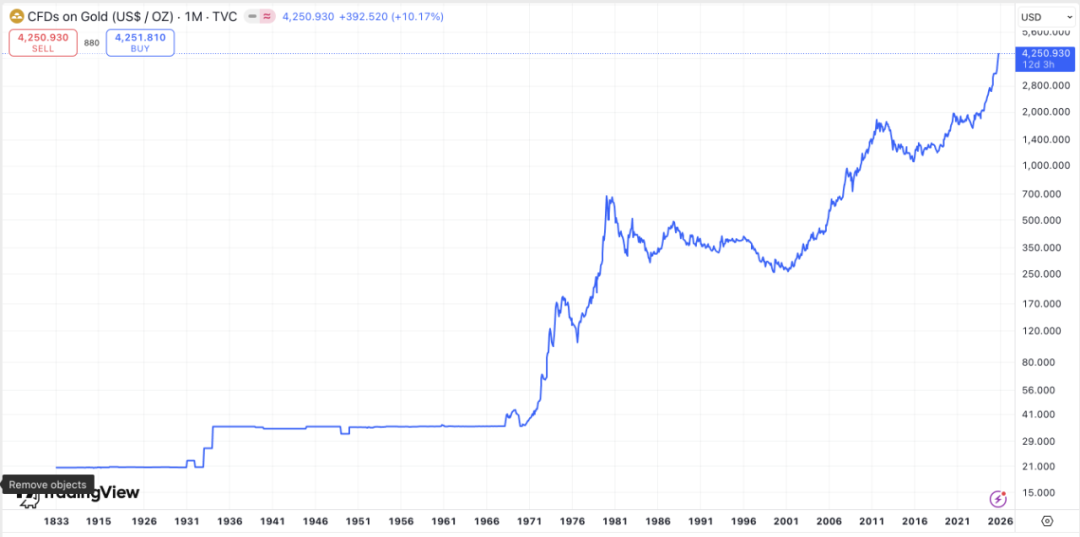Gold prices once surged past $4,378 per ounce, with an increase of over 66% for the year, marking the best annual performance since 1979.
Surge Origins: Dollar Credit Fractures and Multiple Factors Resonating
A Century-Long Game Between Gold and the Dollar
The relationship between gold and the dollar is the key to interpreting gold price fluctuations, with their competitive history tracing back to the twentieth century. In 1944, the Bretton Woods system established a dual peg mechanism of "the dollar linked to gold, and national currencies linked to the dollar," making gold the anchor of dollar credit, with the price fixed at $35 per ounce. In 1971, the Nixon administration announced the decoupling of the dollar from gold, marking the official arrival of the fiat currency era, as gold shifted from a monetary attribute to an investment attribute, yet the negative correlation of "dollar down, gold up" has continued to this day.

Data shows that over the past 50 years, the correlation between gold and the dollar index has been -0.68, particularly pronounced at critical junctures when the dollar credit system faced shocks. For instance, after the collapse of the Bretton Woods system in 1971, gold prices rose from $35 per ounce to $850 per ounce within a decade; during the 2008 financial crisis, a short-term plunge in the dollar index led to gold prices doubling over two years. The gold price surge in 2025 is essentially a reiteration of this historical pattern.
Dollar Credit Crisis: The Core Engine of This Round of Increase
In 2025, the dollar credit system faced multiple shocks, becoming a key driver for gold prices to break through. From a fundamental perspective, the scale of U.S. debt has surpassed $37 trillion, government shutdowns have recurred, regional bank credit crises continue to fester, and the promotion of dollar stablecoins may also weaken dollar credit (as the U.S. government can bypass the Federal Reserve to obtain "curve minting rights" through dollar stablecoins, effectively seizing the digital dollar minting rights and interfering with the Federal Reserve's monetary policy independence)… These issues continuously erode market trust in the dollar. As a non-credit monetary asset, gold does not rely on any national sovereignty backing, making it the preferred tool for hedging against dollar risks.
The Federal Reserve's shift in monetary policy further reinforced the short-term weak dollar situation. On September 17, 2025, the Federal Reserve initiated interest rate cuts, lowering the federal funds rate to 4.00%-4.25%, with the dot plot signaling a further 50 basis points cut within the year, and the market's expectation of a 25 basis points cut in October reached as high as 98%. The dollar index has already fallen over 8% from its peak this year, and the real yield on 10-year U.S. Treasuries dropped from 4.5% to 3.2%. As real yields decline, gold, as a zero-yield asset, sees its allocation value significantly increase.
Geopolitical Risks and Inflation Expectations Resonating Together
In 2025, the global geopolitical risk index rose to a nearly 10-year high, with the ongoing Russia-Ukraine conflict and tensions in the Middle East continuously stimulating market risk aversion. In the past two months, gold prices have seen monthly increases exceeding 10%, highlighting the market's risk-averse sentiment.
On the inflation front, although global core inflation has fallen to 3.2%, it remains above the 2% target of major central banks, and price fluctuations in energy and food caused by geopolitical conflicts may further elevate inflation. Historical data shows that since the collapse of the Bretton Woods system in 1971, gold prices have increased over 50 times, far exceeding the global average inflation rate of 3.5% per year; during the global inflation cycle from 2020 to 2023, gold had an annualized increase of 12.3%, significantly outperforming the 6.8% global average inflation during the same period, and this anti-inflation property has driven continuous inflows into the gold market.
Capital Map: Dual Drivers of Long-term Allocation and Mid-term Investment
Central Banks: "Ballast" Level Long-term Buyers
The continuous accumulation by global central banks is the most stable support for the gold market, and this allocation is not a short-term speculative behavior but a long-term strategy based on national interests. Data shows that global central banks have increased their gold holdings by over 1,000 tons for three consecutive years, with 95% of surveyed central banks expecting to continue increasing their official reserves in the next 12 months. China's central bank has been particularly notable, having increased its gold holdings for 11 consecutive months, with gold reserves reaching 74.06 million ounces by the end of September, a nearly 10% increase from the beginning of the year.
Structurally, central banks in emerging markets are the main contributors to the increase, with their gold reserves' proportion rising from 10% to 18% over the past five years. The core logic behind central banks increasing gold holdings lies in hedging against dollar credit risks, maintaining financial stability, balancing asset portfolios, and combating inflation, essentially achieving diversification of foreign exchange reserves and reducing dependence on dollar assets. The scale of gold reserves is also an important symbol of national credit and financial strength, enhancing international market confidence in the local currency. This "official reserve-level" demand forms a rigid support for gold prices, allowing for quick recovery even in the face of short-term corrections.
Financial Institutions: Core Traders Driven by Strategy
Various financial institutions constitute the backbone of the gold market, exhibiting both trend-driven and strategic characteristics.
Taking public funds as an example, public funds respond passively to investor demand through gold ETFs. In September and October 2025, global gold ETFs saw a net inflow of $17.3 billion in a single month, with the world's largest gold ETF (SPDR Gold Shares) increasing its holdings by 45% compared to the beginning of the year, and the domestic Huaxia Gold ETF (518850) surpassing 30 billion yuan in scale.
Retail Investors: Comprehensive Entry from Consumption to Investment
The large-scale influx of retail funds is also a significant driver of the market, characterized by dual engines of consumption and investment. On the consumption side, traditional gold-consuming countries like China and India have strong demand, with China's wedding market alone consuming over 300 tons of gold annually. In 2025, physical gold sales in jewelry stores grew by 28% year-on-year, and brands like Chow Tai Fook saw gold jewelry prices stabilize at 1,247 yuan per gram while still being in short supply.
On the investment side, performance is even stronger, with retail investment purchases increasing by 45% year-on-year, and sales of gold bars and coins doubling. Products like paper gold and gold accumulation are also highly favored, with Industrial and Commercial Bank of China's "Accumulated Gold" surpassing 50 billion yuan in scale in 2025. The core motivations for retail investors entering the market include hedging against inflation, offsetting stock market volatility, and trend-following, especially after gold prices broke historical highs, significantly amplifying the "chasing effect" on market transaction volumes.
The Real Consideration of Gold's Hedging Function
Value Preservation in Regular Inflation
In a typical inflationary environment, gold's value preservation ability has been repeatedly validated by history. During the global inflation cycle from 2020 to 2023, gold prices rose from $1,700 per ounce to $2,500 per ounce, with an annualized increase of 12.3%, far exceeding the 6.8% global average inflation rate during the same period, effectively safeguarding asset purchasing power.
For individual investors, allocating 5%-10% of assets to gold can effectively hedge against the erosion of wealth due to rising prices. In terms of allocation tools, gold ETFs offer high liquidity and low transaction costs, making them suitable for ordinary investors; physical gold such as bars and coins is favored by investors who prioritize tangible holdings, but storage costs and liquidity constraints need to be considered.
Hedging Boundaries in Extreme Environments
In extreme scenarios such as wars, gold's "crisis hedging" property becomes prominent, but there are also potential risks.
Gold is a cross-cycle wealth carrier. It is the most reliable "asset preservation tool" during wartime and holds irreplaceable value in post-war recovery phases. For example, in post-World War I Germany, hyperinflation triggered by war reparations caused the mark's exchange rate to plummet, with 1 dollar equating to 64 marks in 1921 rising to 4.2 trillion marks in 1923. This meant that residents holding marks saw their wealth evaporate, while those holding gold could maintain their wealth value (in 1923, the mark equivalent of 1 ounce of gold rose from 12,000 marks at the beginning of the year to 4.2 trillion marks by the end of the year, completely hedging against hyperinflation). During such times, holding gold across war cycles can enable rapid wealth recovery post-conflict, allowing gold holders to rebuild homes and invest in industries, while those holding fiat currency may face the risk of currency devaluation.
However, individuals holding gold must be wary of policy risks, as there have been numerous historical cases of governments seizing gold during extreme periods: during World War II, Nazi Germany enacted the "Reich Gold Law," forcing citizens to surrender all gold, with severe penalties for noncompliance; during the Pacific War, Japan implemented the "Gold Control Order," prohibiting private gold ownership; including the U.S. during the Great Depression in 1933, when Congress passed the "1933 Banking Act," abolishing the right to private gold ownership and forcibly confiscating gold at a price of $20.67 per ounce, only to raise the official gold price to $35 per ounce the following year, effectively "buying low and selling high," directly stripping wealth from the public. When a nation faces a survival crisis, personal gold reserves may be at risk of confiscation, which is a boundary of gold's hedging function.
Extended Reflection: Bitcoin vs. Gold?
Essential Differences in Core Attributes
Gold is a safe-haven asset during world wars, while Bitcoin serves as a safe-haven asset to avoid localized conflicts. Gold has been validated over millennia, possessing characteristics of no sovereign backing, no credit risk, and strong scarcity, maintaining its status as the "ultimate non-credit asset." In contrast, Bitcoin's "hedging property" has yet to undergo extreme crisis testing—without computers, smartphones, or even networks and electricity in war-torn areas, Bitcoin cannot function as a direct medium of exchange like physical gold. However, if only localized conflicts occur and people can move to safer areas, Bitcoin is easier to carry than gold.
In terms of scarcity, Bitcoin is more definitive. Gold has limited global reserves and high extraction costs, with only about 3,000 tons added annually, though reports of large gold mine discoveries occasionally arise; Bitcoin's total supply is fixed at 21 million coins, making its scarcity more certain.
Significant Differentiation in Market Structure
The holder structure and market characteristics of the two asset classes differ significantly, determining their price-driving logic. The gold market is dominated by long-term capital, with central banks and long-term institutional investors holding over 60% of the total, allowing it to withstand short-term liquidity shocks.
Bitcoin, on the other hand, is still primarily driven by medium- to short-term capital. Although this cycle has seen an increase in long-term allocation funds (national strategic reserves, Bitcoin ETFs, Bitcoin DATs, etc.), the average daily turnover remains high, and leveraged trading accounts for over 60%. This high turnover and high leverage characteristic makes it more susceptible to being sold off during risk aversion. Additionally, Bitcoin is more correlated with the Nasdaq than with gold, further proving its "risk asset" nature rather than "safe-haven asset" nature.
Future Positioning as Complementary Rather than Substitutable
From a developmental trend perspective, Bitcoin and gold are more likely to form a complementary relationship. Gold, with its millennia of accumulated credit foundation and physical attributes, remains the core reserve asset for global central banks and institutions, holding irreplaceable value in scenarios involving sovereign credit crises and extreme wars; Bitcoin, relying on blockchain technology, demonstrates unique advantages in areas such as inflation hedging, cross-border payments, asset globalization, and global wealth flow.
For individual investors, gold can serve as a "safety net" in an asset portfolio, providing certainty in hedging and value preservation; Bitcoin can be part of a high-risk allocation, seeking excess returns from technological innovations, but investors must endure its price volatility and the uncertainties of regulatory policies in certain regions.
免责声明:本文章仅代表作者个人观点,不代表本平台的立场和观点。本文章仅供信息分享,不构成对任何人的任何投资建议。用户与作者之间的任何争议,与本平台无关。如网页中刊载的文章或图片涉及侵权,请提供相关的权利证明和身份证明发送邮件到support@aicoin.com,本平台相关工作人员将会进行核查。




